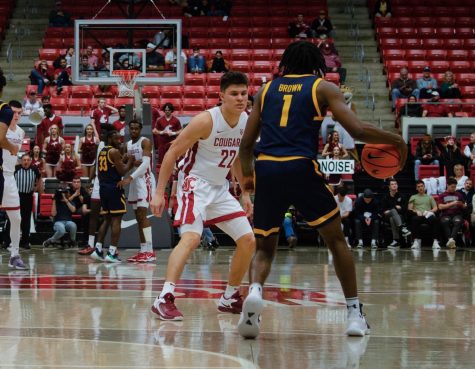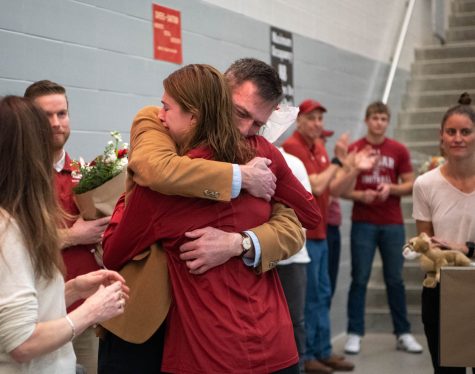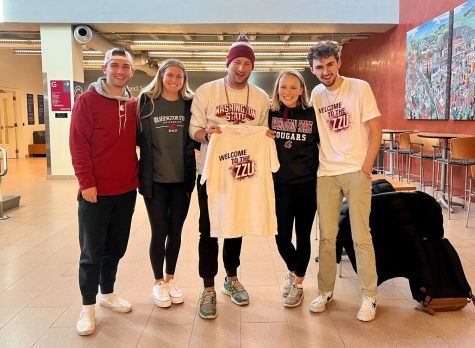No mountain high enough
January 20, 2015
One step. The air was so cold it had frozen the sunscreen on his face into a white mask. Two steps. The exhaustion had hit so hard that his body was shaking and breath was shallow. Three steps. There it was; all the screaming muscles, shortness of breath and mental exhaustion for a panoramic view of an entire state underneath a clear blue sky.
The elation of making it to the top of a small mountain would be enough for most people; the often overwhelming vulnerability of nature’s solitude causes many to avoid extreme conditions, but the call of the wild is stronger for Forrest Heller than most people.
“Pressing that last couple of feet to the summit and that sudden wave of relief of all of your tiredness, all your grogginess, suddenly, in those couple moments, just vanishes as you go ‘Wow, I spent a really, really long time getting up here and here I am. I made it and it was worth it,’” said Heller, a graduate student in chemistry.
From the top of mountains across the Northwest, to braving the sub-zero temperatures on the Palouse, Heller has an insatiable love for the outdoors and the challenges that it presents. But the intense physical challenge of climbing and spending nights outdoors isn’t the driving force behind the unique sense of adventure Heller possesses.
“I think it is the solidarity that you feel out there,” Heller said. ”There are hardly any people, and if you are going through rough places, there is literally just you and your group for miles and miles. Just the solidarity and its calming nature and that quiet that you don’t find in the city.”
Heller has been chasing that calming sense of solidarity since he was a young child. It began in Cub Scouts, when his best friend during the time convinced him to join with teasers of the fun outdoor activities they did.
While many young people fear the outdoors, the dark, and various other rational things, Heller was spending the night in a home-made igloo created from the snow of the neighbor’s yard.
“When he was a kid, he loved snow,” said Heller’s mother, Paula Heller. “When it would snow here he would go and clean off everyone’s sidewalks and driveways and pile it in our backyard, make a snow cave and then sleep in it for a week at a time. As his mother I thought, ‘Okay, you are just right out the back door, you can come in if you want too’… Yeah it was nuts (laughs).”
His love of snow and the cold drew him to his first mountain climbing trip when he was in high school. His mother encouraged him to go despite Heller’s inexperience with climbing at that point. Every day, Heller and his mother would hike up and down a hill with a thousand-something foot elevation in order to prepare. Years later, Heller and his mother still go on the occasional climb together.
Hearing the things that Heller willingly does, you might expect him to be somewhat insane, but that could not be further from the truth. To those who don’t know him, Heller appears to be an average guy. Aside from his soon-to-be master’s degree in chemistry and his lengthy list of mountain climbs and potentially life-ending endeavors, Heller would be considered normal. Nothing about him screams mountain-climbing, sub-zero temperature-braving, staring-death-down man. But being normal is certainly much too boring for Heller’s extraordinary ability to turn another man’s crazy into his own challenge. He breaks the definition of limits, leaving his friends and family to watch in amazement.
Cody Havrilak, one of Heller’s friends from WSU, recalls an excursion to Kamiak Butte on a snowy day one winter when Havrilak’s car was high-centered on a back road.
“After driving along it for a little while, my car began to slide and slow down, and we both instantly realized that I had gotten us high-centered,” Havrilak said. “Forrest slowly turned his head to me with a huge grin and said ‘Dumb a**.’ Then he looked around and calmly asked how he could help get us unstuck… I think that really portrays Forrest’s sense of humor and his calm, level-headedness in potentially stressful situations.”
Whether it is cars stuck in the snow or climbs up technical and dangerous mountains, it is all the same to Heller. His calm mirrors the stillness that surrounds him while he is out in the wilderness. After his first climb, he didn’t stop.
He summited Mt. Baker on his first try, spent two nights on the side of Mt. Adams during the climb up, and summited Mt. Rainier and Mt. Adams, among others. Persevering through climb after climb, he learned to adopt a one-step-at-a-time approach.
“You just go one step at a time and just focus on small steps,” Heller said. “Like, ‘Okay, my foot goes here, okay, it’s stable. Then focus on the next foot. Okay it’s stable. Okay I stepped, now I need to step again. One foot in front of the other.’ Tell yourself, ‘See that little mark in the snow that is maybe ten feet ahead? Let’s just get to that.’…that is also really important when you are up at high altitudes and you have to stop every five or ten steps to catch your breath.”
It still isn’t easy, even one step at a time, what Heller accomplishes. The mental fortitude means even more than the physical ability, and the strength to overcome that provides an entirely different challenge; one that Heller can’t get from the lab.
“There are climbs that can be really physically punishing and you just have to mentally push through them. I tell myself, ‘This sucks but you are okay, you can push on and get to the summit.’”
In return for Heller’s relentless pursuit of the summit, the mountains give Heller a sense of purpose and direction, a calm that can only be found at several-thousand feet. When Heller was let go from his job with Boy Scouts, he climbed. When his uncle passed away suddenly, he climbed. If he ever found himself lost within himself, he climbed. And by the time he reached the summit, he was able to once again find his solace.
“[Since I met Forrest] he’s opened up more, become more social and outgoing,” Havrilak said. “Also, with more outdoors experience, he’s willing and interested to take on new, more challenging situations.”
It is ironic that by pushing himself past his mental and physical limits, he is actually building himself up threw a new found confidence that remains with him.
“For some of the mountains and things I have to try multiple times,” Heller said. “When I do push my limit, I actually go a little bit beyond it … you find you can go a little beyond [your limits] and you have a sense of satisfaction and self confidence that you can push yourself to your limits and sometimes beyond it.”
Nature’s gift of solitude and confidence in himself and his abilities is so important to Forrest that he continues to volunteer with Cub Scouts and Boy Scouts, taking the kids on camping and hiking expeditions just like the ones he participated in. He also participated in volunteer work through local churches in Pullman with high school kids.
“He is willing to help people get what they want also,” Paula said. “He wants to pull them along also with him. Rather than just kind of stepping over people, he wants everyone to be successful and he is willing to help them do that.”
Indicative of everything Heller does, on his third attempt to summit Mt. Adams for the second time, he did the entire climb in one day. Eight and a half hours up and four down. Twelve and a half total hours of grueling climbing to reach the top and return to the bottom again. But to Heller that isn’t extreme; it’s challenging in many ways and enjoyable.
One day, one more step is going to take Heller onto the stage to collect his master’s diploma. One more step is going to make a difference in another young Boy Scout’s life. One more step is going to lift those around him up as well. One more step is going to take him to the top of Everest (the tallest mountain in the world), and the top of K2 (the most difficult mountain in the world). It’s amazing where one more step can get you when you live like Forrest Heller.





















